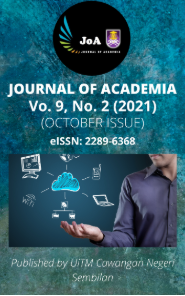PROXIMATE AND PHYSICOCHEMICAL ANALYSIS OF PINK GUAVA JUICE FORTIFIED WITH VITAMIN E
Keywords:
Pink Guava Juice, Vitamin E fortification, Vitamin Fortified Fruit Juice, Pink Guava, Fruit JuiceAbstract
This study is focused on determination of proximate and physicochemical properties of pink guava juice
(PGJ) fortified with vitamin E. Coffee, tea, or carbonated soft drinks are popular however the customer
nowadays is more health conscious and start reducing caffeine-containing beverages from daily intake
and replacing it with fruit juices such as PGJ. In addition, beverages with added value such as vitamin
E that are highly demanded in the fruit juice market globally. The experimental work of this research
are proximate analysis (i.e. protein, carbohydrate, fat, fibre, ash and moisture content) followed by
physico-chemical properties (i.e titratable acidity, pH, total soluble solid (TSS), water activity (aw),
viscosity determination and colour analysis (i.e. lightness (L*), chroma (C*) and hue angle (Ho)).
Results showed that pink guava juice (PGJ) contained protein (0.67 ± 0.15a %), carbohydrate (4.96 ±
0.59a % ), fat (0.27 ± 0.05a % ), total fiber (0.74 ± 0.10a % ), ash (0.64 ± 0.10a % ), moisture (92.72 ± 0.91
a % ), acidity (0.41 ± 0.10 a %), pH (3.65 ± 0.12a), TSS (10.56 ± 0.43a), aw (0.99 ± 0.02a), viscosity (15.33
± 1.15a mPa.s), L* (31.95 ± 0.02a), C* (34.65 ± 0.01a), Ho (25.42 ± 0.02a) and vitamin E content (17.44
± 1.63a mg/l). In conclusion, this study will be useful for preliminary information regarding pink guava
juice and also Vitamin E-Fortification for fruit juice in the future.
References
Aishah, B., Hannah, K. and Zati Alyani, O. (2016a). Stability of selected quality attributes of pink guava juice
during storage at elevated temperatures. International Food Research Journal, 23(5), 1918-1925.
Aishah, B., Zati Alyani, O. And Nor Farahain, M. I. (2016b). Effect of elevated temperature storage on stability
of pink guava juice added with melastoma malabathricum fruit. Journal Teknologi, 78(6), 47-51.
AOAC. (2016). Official Methods of Analysis of AOAC International. 20th Edition, AOAC International,
Maryland, USA.
Campoli, S. S., Rojas, M. L., Amaral, J. E. P. G., Brazaca, S. G. C. and Augusto P. E. D. (2019). Ultrasound
processing of guava juice: Effect on structure, physical properties and lycopene in vitro accessibility. Journal of
Food Chemistry, 268, 594–601.
Chuku, E. C and Akani, N. P. (2015). Determination of proximate composition and microbial contamination of
fresh juice from three citrus species. International Journal of Biology and Medical Research, 1, 1-8.
Garbanzo, C. R., Zimmermann, B. F., Kaysers, N. S. And Schieber, A. (2017). Characterization of phenolic and
other polar compounds in peel and flesh of pink guava (Psidium guajava L. cv. ‘Criolla’) by ultra-high
performance liquid chromatography with diode array and mass spectrometric detection. Journal of Food Research
International, 100, 445–453.
Glover, R. (2019). Natural Source Vitamin E (Tocopherols and Tocotrienols) - A Global Market Overview.
Research and markets, 1, 1-404.
Lamo, C., Shahi, N. C., Singh, A. and Singh, A. K. (2019). Pasteurization of guava juice using induction
pasteurizer and optimization of process parameters. Journal of Food Science and Technology, 112, 108253.
Moon, P., Fu, Y., Bai, J., Plotto, A., Crane, J. And Chambers, Alan. (2018). Assessment of fruit aroma for twenty
seven guava (Psidium guajava) accessions through three fruit developmental stages. Journal of Scientia
Horticulturae, 238, 375–383.
Muramatsu, Y., Sakaguchi, E., Orikasa, T. and Tagawa, A. (2010). Simultaneous estimation of the thermophysical
properties of three kinds of fruit juices based on the measured result by a transient heat flow probe method. Journal
of Food Engineering, 96, 607-613.
Nagarajan, J., Krishnamurthy, N. P., Ramanan, R. N., Raghunandan, M. E., Galanakis, C. M. And Ooi, C. W.
(2019). A facile water-induced complexation of lycopene and pectin from pink guava byproduct: Extraction,
characterization and kinetic studies. Journal of Food Chemistry, 296, 47–55.
Nattawan, K., Pisit, H., Nuchtida, C. (2014). The Effect of Heating on Vitamin E Decomposition in Edible Palm
Oil. International Journal of Environmental and Rural Development, 5-2.
Ninga, K. A., Sengupta, S., Jain, A., Desobgo, Z. S. C., Nso, E. J and De, S. (2018). Kinetics of enzymatic
hydrolysis of pectinaceous matter in guava juice. Journal of Food Engineering, 221, 158-166.
Okokon, E. J. and Okokon, E. O. (2019). Proximate analysis and sensory evaluation of freshly produced apple
fruit juice stored at different temperatures and treated with natural and artificial preservatives. Global Journal of
pure and applied Sciences, 25, 31-37.
Osorio, C., Forero, D. P. and Carriazo, J. G. (2011). Characterisation and performance assessment of guava
(Psidium guajava L.) microencapsulates obtained by spray-drying. Food Research International, 44, 1174–1181.
Parker, R. and Pace, M. (2017). Introduction to Food Science and Food Systems. 2nd Edition, Cangage Learning,
USA.
Shamsudin, R., Mohamed, I. O., and Mohd-Yaman, N. K. (2005). Thermophysical properties of Thai seedless
guava juice as affected by temperature and concentration. Journal of Food Engineering, 66, 395–399.
Silva, N. K. V., Sabno, L. B. S., Oliveira, L. S., Torres, L. B and Sousa P. H. M. (2016). Effect of food additives
on the antioxidant properties and microbiological quality of red guava juice. Artigo Cientifico, 47, 77-85.
Surajbhan, S., Singh, A., Joshi, C., and Rodrigues, L. (2012). Extraction and Optimization of Guava Juice by
Using Response Surface Methodology. American Journal of Food Technology, 7, 326-339.
Suwanwong, Y and Boonpangrak, S. (2021). Phytochemical contents, antioxidant activity, and anticancer activity
of three common guava cultivars in Thailand. European Journal of Integrative Medicine, 42, 101290.
Downloads
Published
Issue
Section
License
Copyright (c) 2021 Journal of Academia

This work is licensed under a Creative Commons Attribution-NonCommercial-NoDerivatives 4.0 International License.












